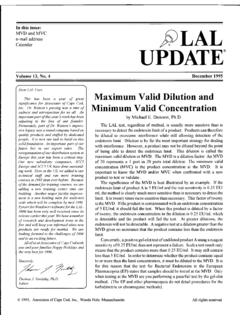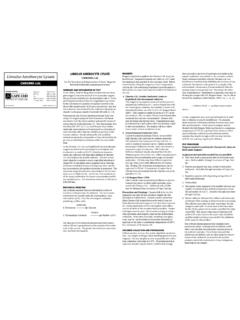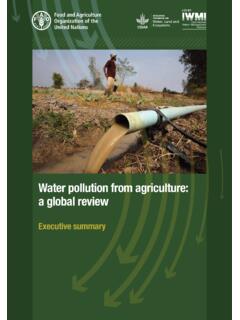Transcription of Calculating Endotoxin Limits for Drug Products
1 14 American Pharmaceutical Review | Endotoxin Supplement 2018 Karen Zink McCullough MMI AssociatesCalculating Endotoxin Limits for drug ProductsAnalysts working on Bacterial Endotoxins Test (BET) method development are often presented with new compounds or new Products , and are asked to calculate an Endotoxin limit, develop a test method for the new material and transfer the validated test method to QC. What is an Endotoxin limit and what information do Assay Developers need to know in order to calculate one?Endotoxins are components of the outer layer of the outer cell membrane of Gram negative bacteria. Although endotoxins can have a number of biological effects if injected into mammals, the focus of current BET assays is to determine if there are sufficient levels of endotoxins in or on materials that could cause a fever in a patient.
2 Since Gram negative bacteria are ubiquitous in nature, endotoxins are likely present in most raw materials and parenteral Products at some level. To assess the safety of drug Products , the compendial BET measures the levels of resident endotoxins against a product-specific, dose-dependent, route of administration-dependent and time of administration-dependent calculation called the Endotoxin limit (Weary, 1990). The formula for Calculating an Endotoxin limit in parenterals is generally noted as K/M, where K = the Threshold Pyrogenic Dose and M is the dose of the drug in units/kg/hr. K =Threshold Pyrogenic Dose K , the numerator of the Endotoxin limit formula, is the Threshold Pyrogenic Dose (TPD). This is a constant, and represents a statistical assessment of the levels of Endotoxin activity that it takes to induce a fever in a rabbit.
3 (Wachtel and Tsuji, 1976; Dabbah, et al, 1980). As a result of these studies, 5 EU/kg/hr is the TPD for Products administered intravenously (IV) or intramuscularly (IM). If a product is administered Intrathecally (IT), meaning the material is injected into the space that holds cerebrospinal fluid, K is lowered to EU/kg/hr. If the drug product is a radiopharmaceutical, K = 175 EU for non-intrathecal routes of administration and 14 EU for intrathecal people, and in fact even some current Guidance documents get confused, and think that K alone is the Endotoxin limit. However, K is only one part of the = Dose/kg/hr M , the denominator in the Endotoxin limit formula, is the maximum dose of the material per kg of patient and per hour of total administration. The dose of the material is historically interpreted to mean the dose of the active ingredient unless the product is administered on a volume/kg basis.
4 If the target patient population is adults, it is generally assumed that the average adult in the US weighs 70kg. However, the average adult in Japan is assumed to weigh 60 kg. If the target patient population is a spectrum of patients, the maximum dose/kg/hr is generally the largest dose given to the smallest patient in the target group. Average patient weights for children can be found on the Center for Disease Control Growth Charts, If the largest dose/kg/hr is the pediatric dose for a given drug product, then it is used as M. If the product is a veterinary product and can be administered to a number of different animals, the maximum dose/kg/hr is generally the highest dose given to the smallest animal. Although these are rules of thumb , they should be confirmed by calculation of dose/kg/hr for a number of examples representing the extremes of the target patient populationENDOTOXIN LIMITSK aren Zink McCullough is principal consultant at MMI Associates, a consulting firm focusing on Quality System development and pharmaceutical microbiology.
5 Ms McCullough is nationally and internationally known for her work in the Bacterial Endotoxins Test (BET ), and is a frequent speaker, instructor author on such topics as BET, GMP, Metrics, Risk, and pharmaceutical microbiology. Her credits include editing two books on Microbiology and BET, authoring 26 book chapters and 19 published articles. Ms. McCullough received her BA degree in Bacteriology from Rutgers University and her MS in Molecular Biology from the University of Oregon. Because radiopharmaceuticals have a half-life and the dose increases as the drug reaches expiration, M for radiopharmaceuticals is equal to the maximum volume of the drug that can be administered at the time of expiration. Table 1. Values for K and MRoute of AdministrationKMIntravenous for parenteralsParenteral injections other than intravenous (intramuscular, subdermal)5 EU/kg of body weightMaximum dose of drug product/kg administered in one hourIntravenous for radiopharmaceuticals175 EUVolume of the maximum recommended dose at the time of expirationIntrathecal for EU/kg of body weightMaximum dose of drug product/kg administered in one hourIntrathecal for radiopharmaceuticals14 EUVolume of the maximum recommended dose at the time of expirationNote: Some Products , for example Water for Injection, many large volume parenterals and intraocular fl uids where there is no specifi c dose have assigned Endotoxin Limits , not calculated ones.
6 Calculating Endotoxin LimitsThe story begins. The Product Development group (PD) sends the Assay Development lab (AD) an email with thanks in advance for Calculating the Endotoxin limit for a hot new product where the dose is 50mg. 1. The AD assumes that the dose is 50mg/kg administered as a bolus intramuscular injection for an adult population and their calculation is:K/M = (5 EU/kg/hr) (50 mg/kg/hr) = The AD group send this information back to the PD group and the PD group says, Sorry. We forgot to tell you that the dose is 50mg/person. The AD takes that information into account, assumes that the patient population is adults and recalculate the limit:Dose/kg = (Dose/person) (kg/person) = (50 mg/person) (70 kg/person) = = (5 EU/kg/hr) ( mg/kg/hr) = Wouldn t you know, the Director of PD calls back and says that the marketing group has interviewed a number of Key Opinion Leaders (KOL) 15 American Pharmaceutical Review | Endotoxin Supplement 2018 Endotoxin LIMITSand these KOLs are looking for an intrathecal administration for this new hot drug .
7 Can the AD please re-calculate the Endotoxin limit? The AD assumes that the dose is 50mg/kg/hr for the intrathecal administration, and their new calculation isK/M = ( EU/kg/hr) (50 mg/kg/hr) = Another e-mail comes from PD. Sorry, the intrathecal administration in example 3 isn t 50 mg/kg, it s 50 mg/adult person. Back to the drawing = (Dose/person) (kg/person) = (50 mg/person) (70 kg/person) = = ( EU/kg/hr) ( mg/kg/hr) = Oops. The KOLs also want to do an IV infusion over the course of 6 hours. Again, the AD is asked to calculate the Endotoxin limit and assumes that the total dose is 50mg/kg. But now they need to adjust for the length of = (total dose/kg) (number of hours of administration) == (50 mg/kg) (6 hours) = mg/kg/hr K/M = ( EU/kg/hr) ( mg/kg/hr) = The AD then gets a call from the Japanese marketing group who wants to administer this 50mg as a whole person bolus injection for adults, but also a whole person bolus injection of 35mg to children with an average weight of 20kg.
8 Adult Dose/kg = (Dose/person) (kg/person) = (50 mg/person) (60 kg/person) = mg/kgK/M = (5 EU/kg/hr) ( mg/kg/hr) = Dose/kg = (Dose/person) (kg/person) = (35 mg/person) (20 kg/person) = mg/kgK/M = (5 EU/kg/hr) ( mg/kg/hr) = has the AD learned?1. Never assume. Be certain you get all of the information that you need before you start Calculating . Calculation of the Endotoxin Limits requires three pieces of vital information: Route of administration. For IV and IM administration, K = 5 EU/kg. For intrathecal administration K = EU/kg. Dose per kilogram of patient. If the dose is given as a whole person dose, it must be adjusted by dividing the dose by the weight of the target population to get dose/kg. If the same whole person dose applies to both adults and children, the pediatric dose/kg/hr will be higher than the adult dose/kg/hr.
9 Dose per hour. If the total dose is administered by an infusion lasting n hours, it must be adjusted by dividing the total dose by the length of the administration to get the examples above, the AD calculated seven diff erent Endotoxin Limits for the initial request where the dose was given as 50mgTable 2. Comparison of Endotoxin Limit Calculations for Examples 1-6 (above)ExampleRoute of AdministrationDose/kg/hrEndotoxin Limit (EU/mg)Comments1IM50 50 to adjust for dose/kg because information on the dose was provided as whole person dose3IT50 = EU/kg/hr because of IT to adjust for dose/kg because information on the dose was provided as whole person dose, but use K = EU/kg to calculate the to adjust for dose/hr because of the 6 hour to adjust for Japanese dose/kg because information on the dose was provided as a whole person to adjust for child dose/kg because information was provided as a whole person dose2.
10 For any given route of administration, the Endotoxin limit is inversely proportional to the dose. The lower the dose, the higher the limit per unit dose. Think about it this way: If the dose is 1 mg/kg/hr, the Endotoxin limit is (5 EU/kg/hr) (1 mg/kg/hr) = 5 EU/mg If the dose is 10 mg/kg/hr, the Endotoxin limit is (5 EU/kg/hr) (10 mg/kg/hr) = EU/mg If the dose is 100mg/kg/hr, the Endotoxin limit is (5 EU/kg/hr) (100 mg/kg/hr) = EU/mg3. There can be many Endotoxin Limits for one product depending on what the PD group predicts or what the fi nal package insert says about dosing and administration. To fi nd the LOWEST Endotoxin limit for any given formulation, ALL combinations of route of administration, dose/kg and dose/hr provided to the laboratory or described in the package insert should be calculated.










